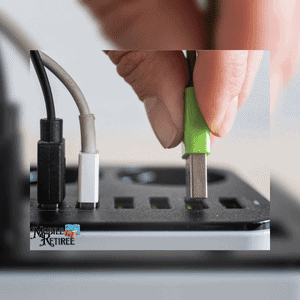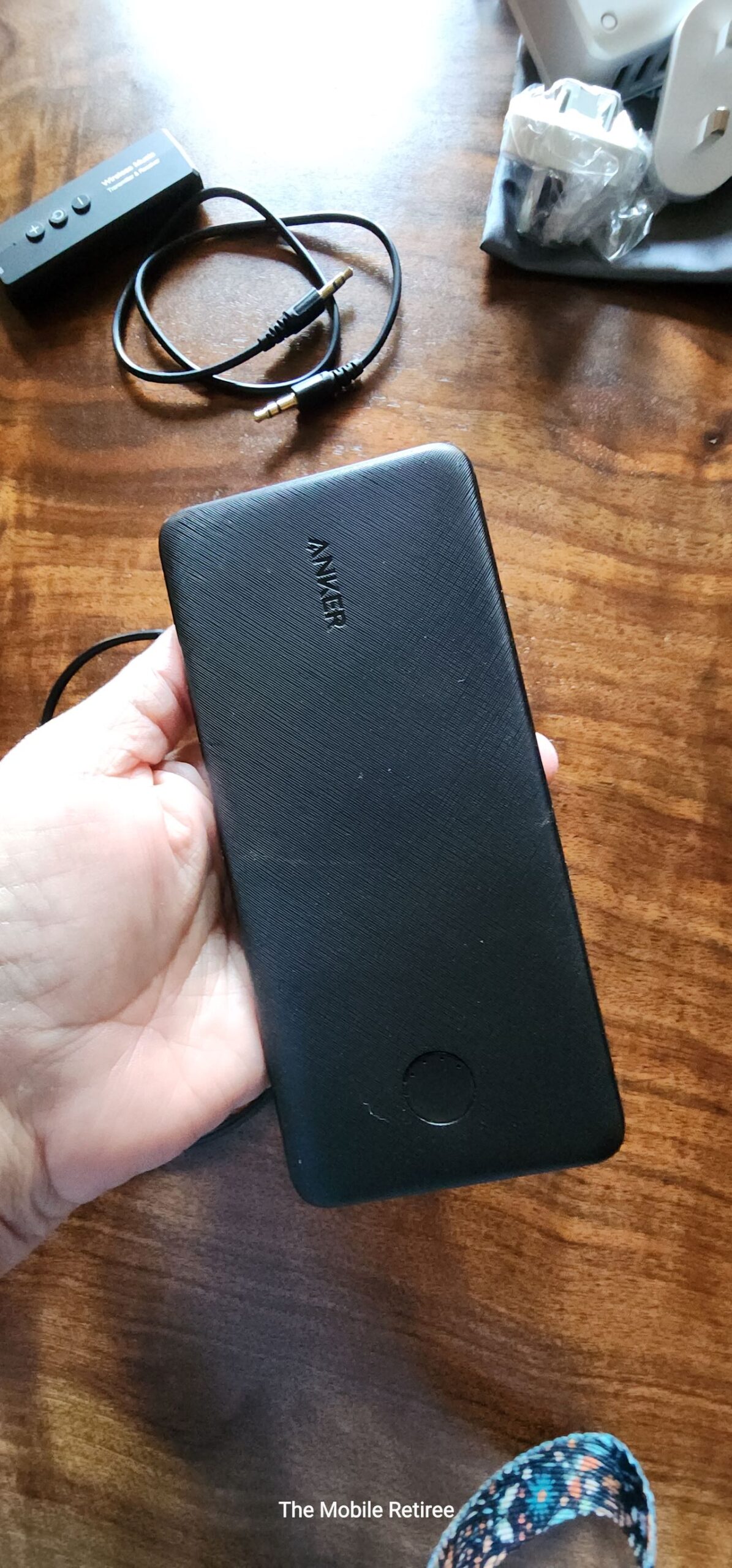Practical advice on safe and efficient travel tech management for fulltime travelers
(read before you leave)
Traveling light is more than just packing fewer clothes; it’s about optimizing the travel tech accessories you bring along. For those of us embracing fulltime travel with only what we can carry, optimizing our electronic setup becomes crucial.
Prior to leaving on our first year of fulltime travel, I spent some time researching travel accessories like chargers and cables, to simplify our life abroad. With the rise of digital threats, I became particularly interested in finding USB-A to USB-C cables designed solely for charging my electronic devices, particularly our phones, without data transfer capabilities. Here’s what I discovered, along with some tips that might help you make better choices for your next trip.
Avoiding “Juice Jacking” & USB Charging Risks
First, let’s talk about USB charging security. We’ve all been tempted to plug into a handy airport or café charging station, right? But, I’ve read enough horror stories about malware lurking in public USB ports (also known as “juice jacking”) to make me think twice. It might sound a bit like fear-mongering, but there’s no doubt that the risk is real, even if cases are rare.
How does it happen? When you plug your device into a compromised port, malware can sneak in through the connection, potentially messing with your phone’s data or even hacking your sensitive information. One easy way to protect yourself is by using a USB cable that’s designed solely for charging, not data transfer. These power-only cables cut the data connection, minimizing the risk of malware being transmitted.
I know what you’re thinking—“That’s it? A special cable can keep me safe?” Well, yes and no. While these cables are a solid precaution, I recommend avoiding public USB ports altogether when you can. Why take the chance when there are safer alternatives?
As an additional security measure, always use a VPN when connecting to public networks, okay.
Battery Packs: Your Safety Net When Traveling
Enter the humble external battery pack aka power bank. Instead of plugging your phone directly into public ports, charge up your power bank and then charge your phone from the power bank. This extra step gives you a buffer between your device and any potential threats. It’s a bit more effort, sure, but that peace of mind is worth it, especially when your phone contains as much personal information as mine does.
Between Sandra and me, we each carry a small Anker battery pack for on-the-go recharging—think sightseeing days when you’re using your phone’s GPS and camera constantly. I also carry a larger battery for long-haul needs, like powering my CPAP machine overnight. These batteries have been lifesavers during long travel days when outlets are scarce.
Another option is to rely on electrical outlets when available, using a multi-port charging block. These blocks are incredibly convenient, especially when outlets are in short supply, as is often the case in hotels and airports.
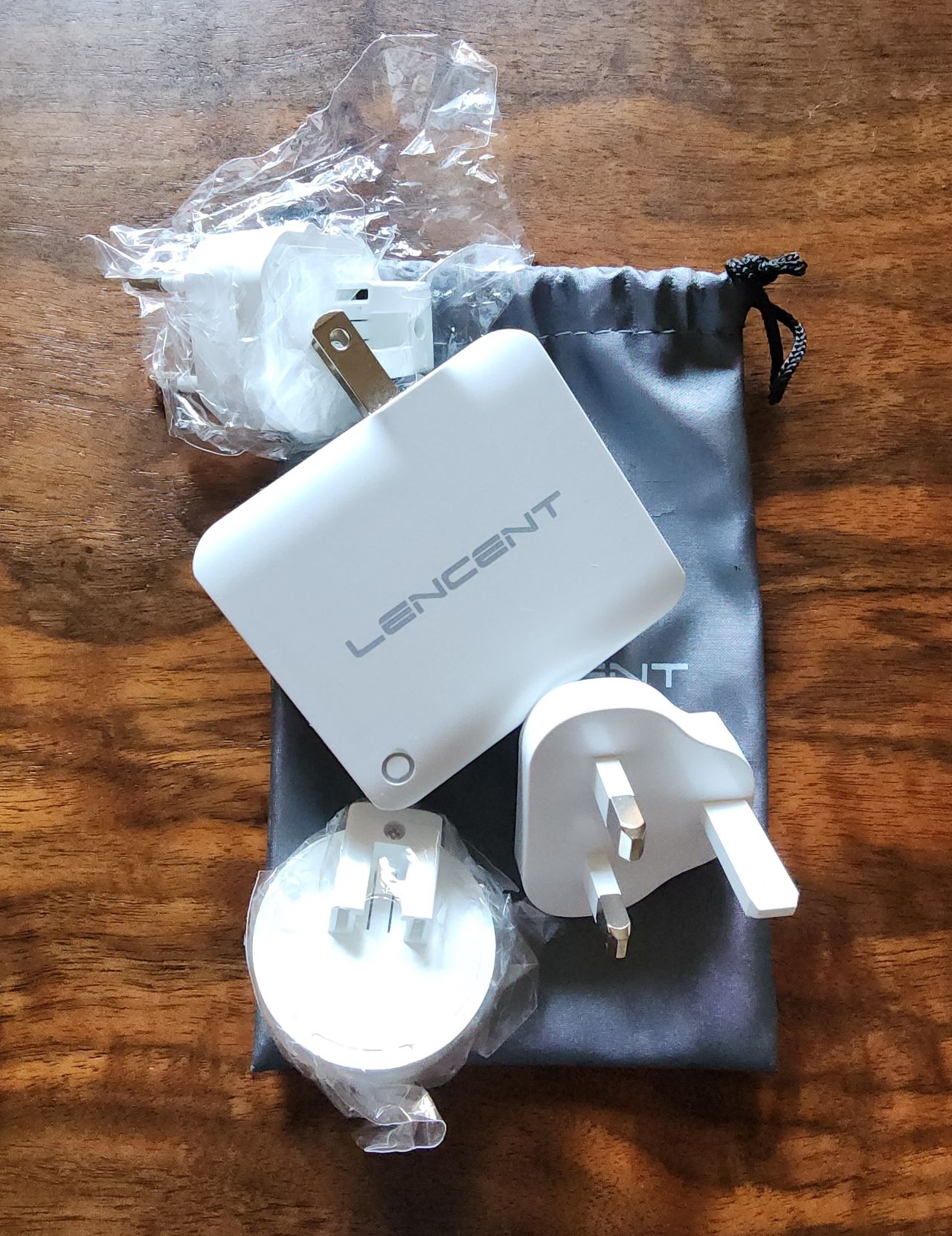
I have carried a multi-outlet extension cord with me for years because it seems to never fail that the one usable outlet in a hotel room is on the opposite side of the room from the nightstand and I really like to have my travel cpap machine and my phone in arms reach at night.
Understanding the Power Behind Multi-Port USB Charging Blocks
While researching multi-port USB charging blocks, I was surprised to find that they range from basic models to more advanced versions offering up to 185 watt chargers with 6 or 7 ports. The higher wattage models can even charge laptops or tablets, not just phones. Hmmm, what’s that all about ? 185 watts seems like a lot. Turns out that some of them have usb ports with much higher current capability that could be used to charge a laptop or tablet.
This discovery led me to consider whether I could eliminate the bulky laptop charging bricks entirely. If a single, compact charging block could handle all our devices—two phones and two laptops—it would significantly reduce the number of cables and chargers we need to carry.
Curioser and curioser… If we got one of those devices then could we do away with the regular ‘bricks’ that our laptops charge from at home? I’m all about standardizing and reducing the number of cables we carry around and if we could also use one device to replace 2 cell phone chargers and two laptop chargers, that would be pretty interesting to me as well.
Multi-Port USB Chargers: Less Bulk, More Power
Speaking of outlets, I’m a fan of multi-port USB chargers. Ever found yourself in a hotel with one outlet by the bed and three devices that need charging? It’s a common problem. That’s why I always pack my USB charger with multiple ports (Sandra uses this one). Some of these chargers even have higher wattage ports that can charge laptops and tablets—yes, laptops! This was a game-changer for us. Imagine ditching those heavy laptop charging bricks and using one sleek, multi-port block to charge everything from your phones to your laptops.
The trick here is to look for higher-wattage chargers, like 100W or more, that have enough juice to handle larger devices. I’m always looking to trim down our gear, and if one block can replace multiple bulky chargers, sign me up. I’m currently testing a 45W charger with a USB-C port that’s compatible with my Lenovo laptop, and while it charges a bit slower than my original brick, it’s worth it for the space and weight savings.
Packing Light: Optimizing Cables and Chargers
One of the biggest challenges for nomads is balancing tech needs with space. I’ve experimented with different cable setups, and here’s where I’ve landed: a mix of long and short cables, plus a few adapters to keep things flexible.
For example, I carry two 10-foot reinforced cables—one USB-A to USB-C for our phones and a USB-C to USB-C for my laptop. These longer cables are handy in hotel rooms where outlets are never conveniently located. I also have a couple of shorter cables for charging on the go, like when we’re out exploring and I need to top off my phone battery from the power bank.
Adapters are also key. I pack a USB-A to USB-C adapter, which lets me use my laptop’s USB-C cable for lower-wattage devices. This might seem like overkill, but when you’re traveling full-time with carry-on bags only, every cable you can eliminate counts.
Real-World Application (Personal Experience)
What Worked for Us: Our Current Travel Setup
In the end, after looking at available options, we left with a simpler set of solutions. Taking into account the need for both voltage conversion and plug conversion, we pared down to the minimum we thought would work for us.
Between Sandra and I we carry three battery packs. We each have a small one that can be used on activity days to recharge our phones or the GoPro camera – she has a nice one that’s 10,000mAh and I am still using one I got as part of a Subabru promo that’s like 3000mAh. I also have a larger capacity battery pack that can power my C-PAP machine overnight while also charging my phone.
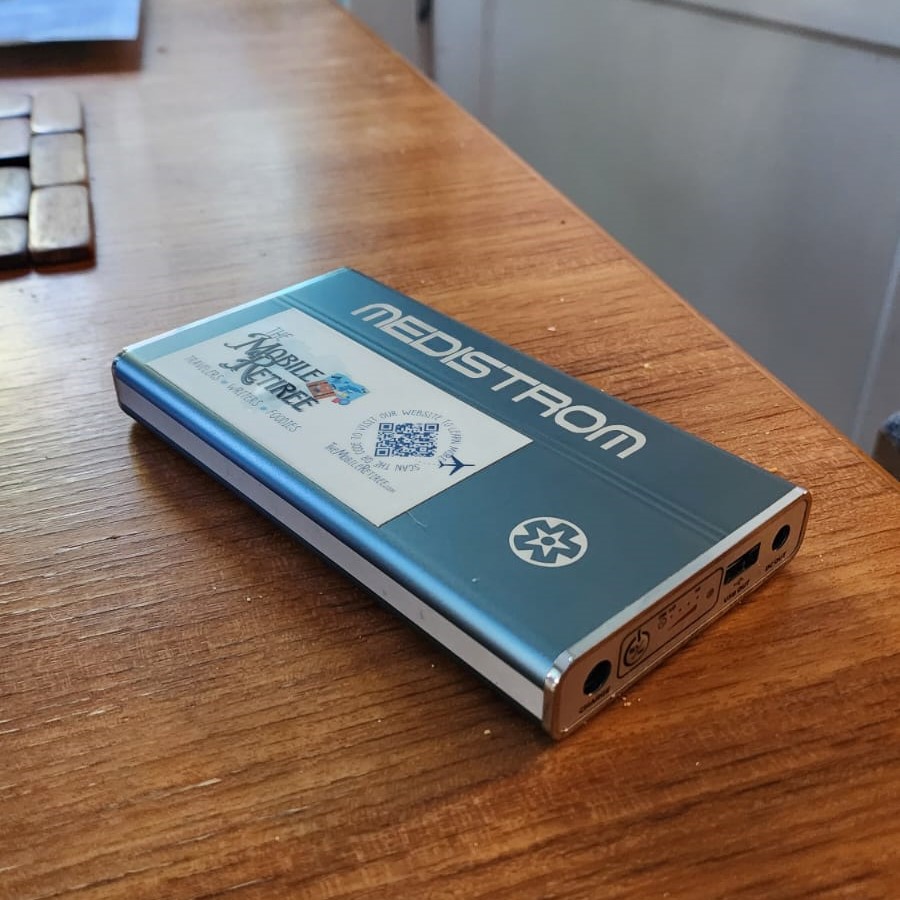
The travel adaptor I selected includes a 45W type-C port that I use to charge my laptop. It’s a Lenovo with a USB-C input so I don’t carry the ‘brick’ that came with it which save weight and space. The trade-off is that the charging rate is much slower. Most of the time that doesn’t matter; I leave it to charge overnight or when I’m heavy into video editing I just keep it plugged in while I work. Sandra also carries the brick that came with her laptop, just in case, which is a good thing for when we both need to charge our laptops but aren’t in the same space such as now when we are at two different petsitting situations.
We have a variety of cables, my bag includes a pair of 10 foot reinforced cables and a couple of short ‘regular’ cable. A short cable is useful when we are out and about to recharge my phone from the battery pack. The long cables include a USB-A to USB-C for the phone and a USB-C to USB-C for charging the laptop. I also carry a USB-A to USB-C adaptor so I can use the laptop cable for lower wattage devices.
When traveling full-time and following a ‘carry-on bags only’ plan, every ounce may as well be a pound. We have done what we can to minimize weight and volume while maintaining a safety margin on our ability to use all the necessary electronics
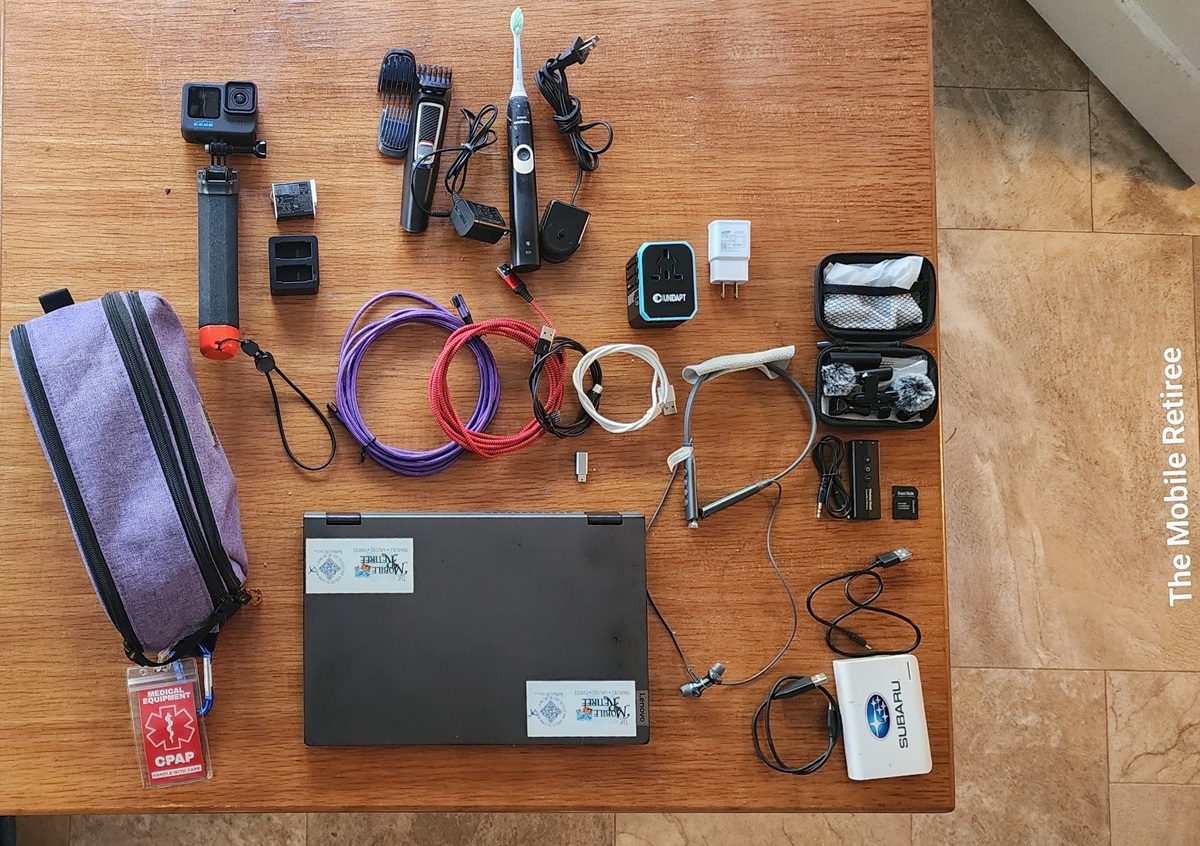
Laptop, cables and adaptors, GoPro camera with extra battery and lavalier mic set, backup battery pack, electric toothbrush (a luxury I’ve argued with myself about quite a few times), beard/hair trimmer, Bluetooth headset, even a Bluetooth device that can be plugged into the audio port on an In-Flight Entertainment system so I can use my wireless headset instead of the cheap corded ones the airline provides.
Final Thoughts: Streamlining Your Tech for Nomadic Life
Fulltime travel demands efficiency, and that extends to how you manage your travel tech. With the right combination of cables, chargers, and battery packs, you can reduce bulk and stress without compromising on safety or convenience. Whether you’re a tech enthusiast or a casual user, optimizing your travel tech gear can significantly smooth out life on the road.
As we continue our nomadic journey, we’ll keep testing and refining our tech setup. Stay tuned for more insights on what works (and what doesn’t) for long-term travelers like us. Remember, in the world of nomadic living, every ounce saved is a step towards greater freedom and flexibility.
Travel Tech Accessories Checklist
To simplify your packing, we’ve put together a list of the exact tech accessories we use while traveling. These are tried-and-true items that help us stay connected and efficient while traveling fulltime, while keeping things lightweight and streamlined. From multi-port chargers to portable battery packs, this list has everything you need to make your next trip more convenient and stress-free. We hope it helps you find the right gear for your travel needs!
USB Charging Cables
- This one is nice because it is allows for fast charging and is a 3-in-1 USB C cable that can go either way, straight in as a Type C or as a Type A with the attached converter
- We also carry these reinforced USB-C to USB-C Dual Right Angle charge cables
Power Banks aka External Battery Packs
- For phones: A high-capacity power bank (10,000mAh or more) is crucial to keep your devices charged on the go. Our fan favorite brand is Anker.
- Larger pack for power-intensive devices (e.g., C-PAP machine).
Multi-Port USB Charging Block
- At least 45W Type-C port for laptops. This one supports most of your devices: including your travel hair dryer, shaver, laptop, curling iron, digital camera, tablet, bluetooth speakers, headphones and more.
- Multiple USB Wall Charger – allows you to charge 4 devices simultaneously, suitable for charging phones, tablets, headphones, power banks, camera batteries and other travel essential
Travel Adaptor
- Universal plug adaptor – A universal travel adapter ensures you can plug into any outlet around the world.
Miscellaneous Cables, Adapters and Handy Accessories
- Handy USB-A to USB-C adapter
- Bluetooth headset – these are a fan favorite! Hangs around your neck so you don’t lose them.
- In-flight audio adapters – allows you to connect your wireless headset to the plane’s entertainment system
- Tech Organizer – Keep all your charging cables and adapters neatly organized. The last you need is all your little bits scattering on the floor during a checkpoint.


